Abstract
To investigate the ability of anthrax toxin lethal factor (LF) to translocate foreign proteins into the cytosol of eukaryotic cells and to characterize the structural requirements of this process, fusion proteins containing a portion of LF and the catalytic domains of either diphtheria toxin or Shiga toxin were constructed. Previous work showed that residues 1 to 254 of anthrax toxin lethal factor (LF1-254) are sufficient for binding to the protective antigen component of the toxin and that portions of Pseudomonas exotoxin A fused to LF1-254 are efficiently translocated to the cytosol of eukaryotic cells (N. Arora and S. H. Leppla, J. Biol. Chem. 268:3334-3341, 1993). In this study, it was found that fusion proteins containing the ADP-ribosylation domain of diphtheria toxin fused at either the amino end or the carboxyl end of LF1-254 are highly toxic to Chinese hamster ovary (CHO) cells, indicating that translocation does not strictly require that the amino terminus of LF be free. A fusion protein containing the ribosome-inactivating A1 subunit of Shiga toxin fused to the carboxyl terminus of LF1-254 was also highly toxic for CHO cells. All fusion proteins were toxic only when administered with the anthrax toxin protective antigen component. The data show that the combination of protective antigen and LF fusion proteins can efficiently import polypeptides from diverse bacterial sources to the cytosol of eukaryotic cells and that LF fusion proteins may have the passenger polypeptides fused at either the amino terminus or the carboxyl terminus of LF1-254. These LF fusion proteins could potentially be used as components of a therapeutic agent when the destruction of certain types of cells is desired (e.g., in treating cancer).
Full text
PDF
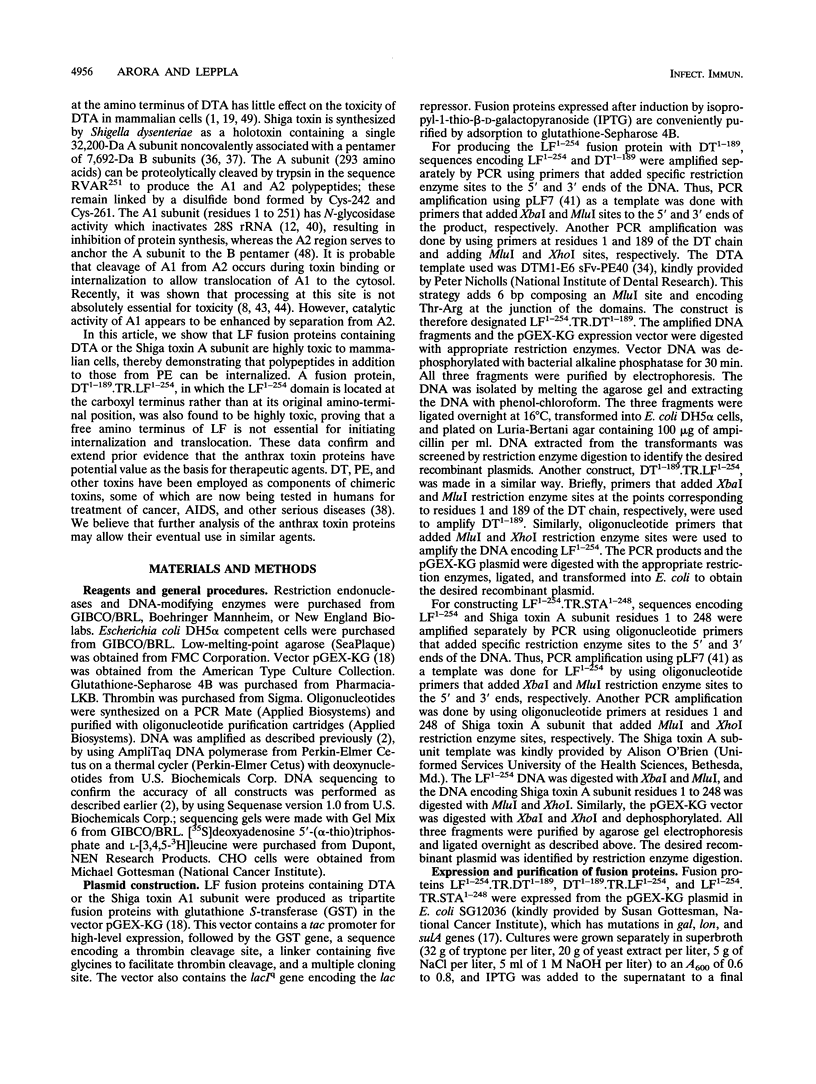
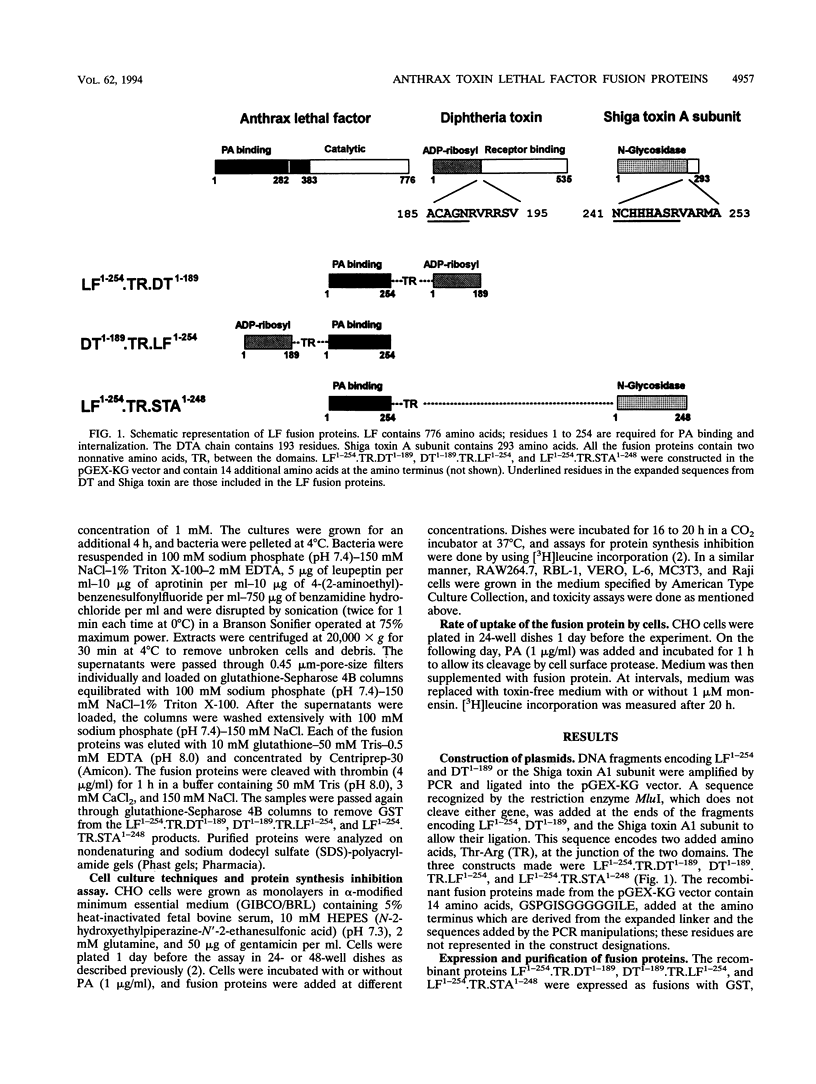
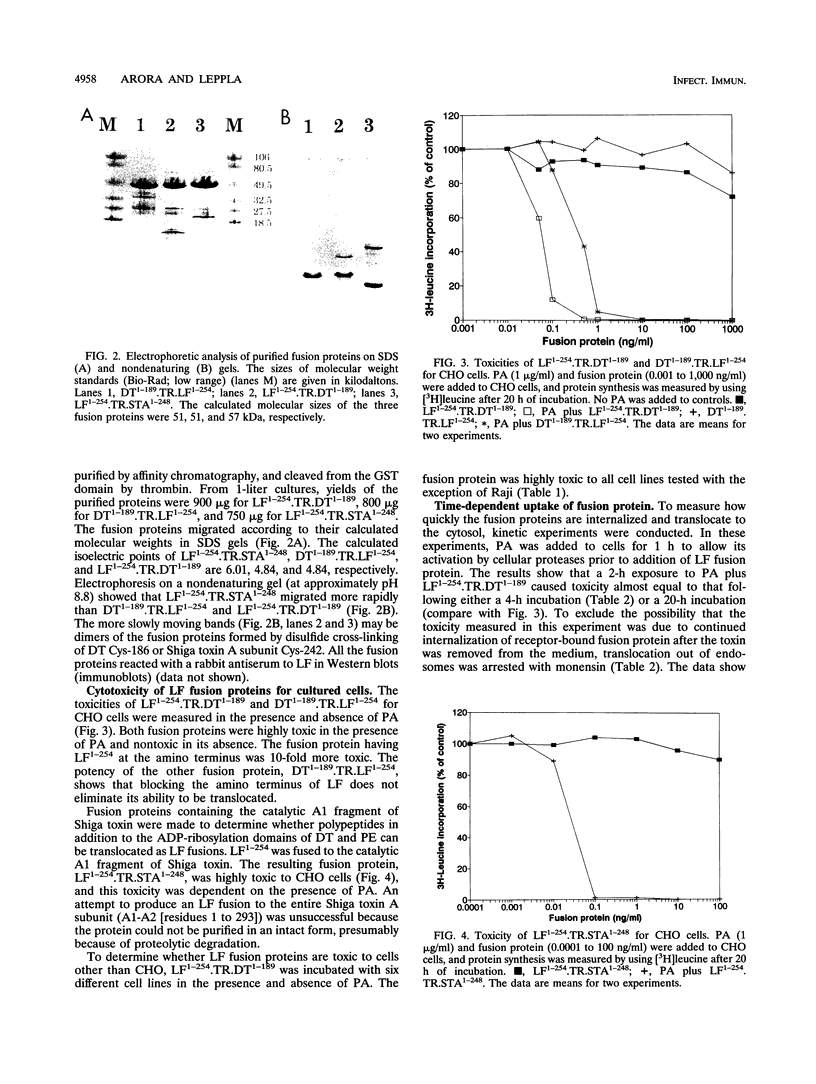

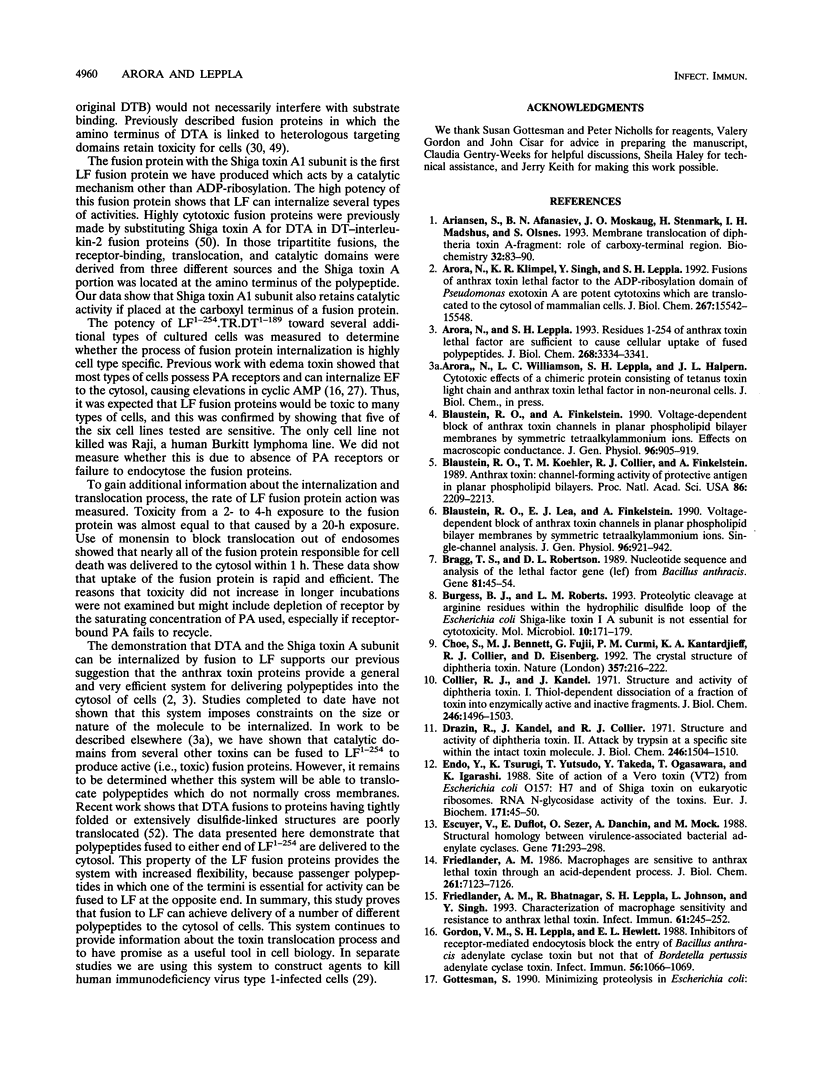
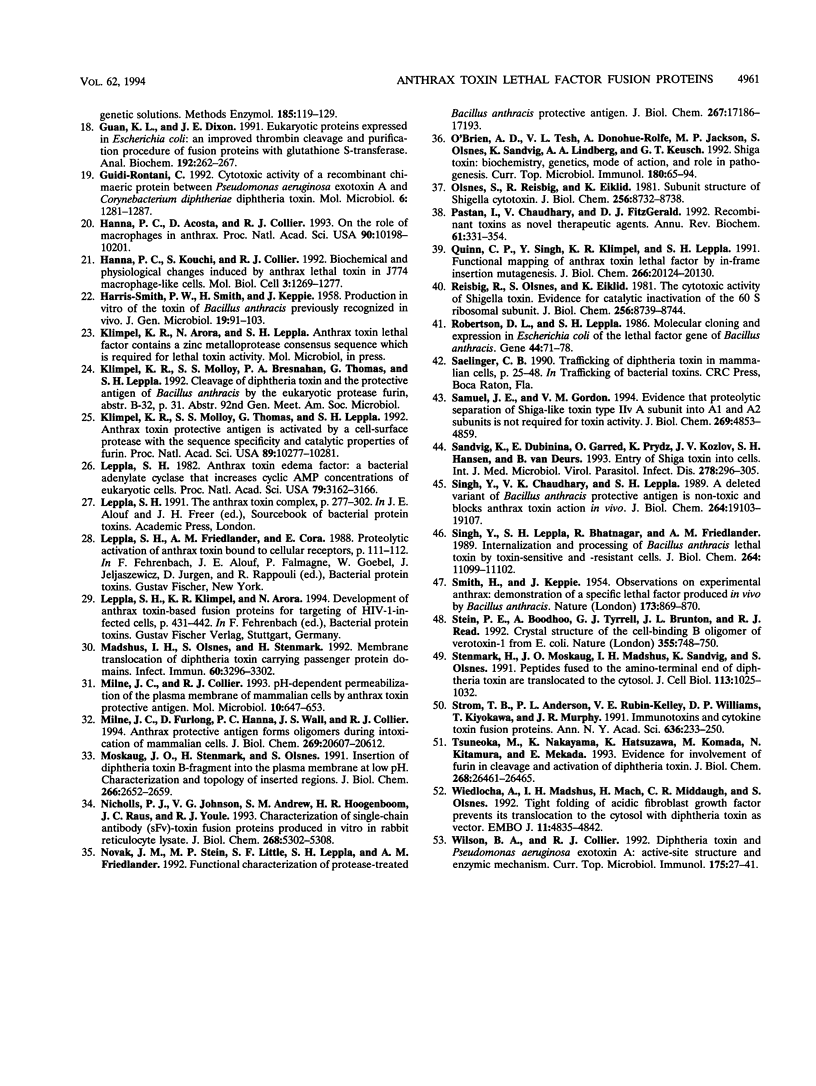
Images in this article
Selected References
These references are in PubMed. This may not be the complete list of references from this article.
- Ariansen S., Afanasiev B. N., Moskaug J. O., Stenmark H., Madshus I. H., Olsnes S. Membrane translocation of diphtheria toxin A-fragment: role of carboxy-terminal region. Biochemistry. 1993 Jan 12;32(1):83–90. doi: 10.1021/bi00052a012. [DOI] [PubMed] [Google Scholar]
- Arora N., Klimpel K. R., Singh Y., Leppla S. H. Fusions of anthrax toxin lethal factor to the ADP-ribosylation domain of Pseudomonas exotoxin A are potent cytotoxins which are translocated to the cytosol of mammalian cells. J Biol Chem. 1992 Aug 5;267(22):15542–15548. [PubMed] [Google Scholar]
- Arora N., Leppla S. H. Residues 1-254 of anthrax toxin lethal factor are sufficient to cause cellular uptake of fused polypeptides. J Biol Chem. 1993 Feb 15;268(5):3334–3341. [PubMed] [Google Scholar]
- Blaustein R. O., Finkelstein A. Voltage-dependent block of anthrax toxin channels in planar phospholipid bilayer membranes by symmetric tetraalkylammonium ions. Effects on macroscopic conductance. J Gen Physiol. 1990 Nov;96(5):905–919. doi: 10.1085/jgp.96.5.905. [DOI] [PMC free article] [PubMed] [Google Scholar]
- Blaustein R. O., Koehler T. M., Collier R. J., Finkelstein A. Anthrax toxin: channel-forming activity of protective antigen in planar phospholipid bilayers. Proc Natl Acad Sci U S A. 1989 Apr;86(7):2209–2213. doi: 10.1073/pnas.86.7.2209. [DOI] [PMC free article] [PubMed] [Google Scholar]
- Blaustein R. O., Lea E. J., Finkelstein A. Voltage-dependent block of anthrax toxin channels in planar phospholipid bilayer membranes by symmetric tetraalkylammonium ions. Single-channel analysis. J Gen Physiol. 1990 Nov;96(5):921–942. doi: 10.1085/jgp.96.5.921. [DOI] [PMC free article] [PubMed] [Google Scholar]
- Bragg T. S., Robertson D. L. Nucleotide sequence and analysis of the lethal factor gene (lef) from Bacillus anthracis. Gene. 1989 Sep 1;81(1):45–54. doi: 10.1016/0378-1119(89)90335-1. [DOI] [PubMed] [Google Scholar]
- Burgess B. J., Roberts L. M. Proteolytic cleavage at arginine residues within the hydrophilic disulphide loop of the Escherichia coli Shiga-like toxin I A subunit is not essential for cytotoxicity. Mol Microbiol. 1993 Oct;10(1):171–179. doi: 10.1111/j.1365-2958.1993.tb00913.x. [DOI] [PubMed] [Google Scholar]
- Choe S., Bennett M. J., Fujii G., Curmi P. M., Kantardjieff K. A., Collier R. J., Eisenberg D. The crystal structure of diphtheria toxin. Nature. 1992 May 21;357(6375):216–222. doi: 10.1038/357216a0. [DOI] [PubMed] [Google Scholar]
- Collier R. J., Kandel J. Structure and activity of diphtheria toxin. I. Thiol-dependent dissociation of a fraction of toxin into enzymically active and inactive fragments. J Biol Chem. 1971 Mar 10;246(5):1496–1503. [PubMed] [Google Scholar]
- Drazin R., Kandel J., Collier R. J. Structure and activity of diphtheria toxin. II. Attack by trypsin at a specific site within the intact toxin molecule. J Biol Chem. 1971 Mar 10;246(5):1504–1510. [PubMed] [Google Scholar]
- Endo Y., Tsurugi K., Yutsudo T., Takeda Y., Ogasawara T., Igarashi K. Site of action of a Vero toxin (VT2) from Escherichia coli O157:H7 and of Shiga toxin on eukaryotic ribosomes. RNA N-glycosidase activity of the toxins. Eur J Biochem. 1988 Jan 15;171(1-2):45–50. doi: 10.1111/j.1432-1033.1988.tb13756.x. [DOI] [PubMed] [Google Scholar]
- Escuyer V., Duflot E., Sezer O., Danchin A., Mock M. Structural homology between virulence-associated bacterial adenylate cyclases. Gene. 1988 Nov 30;71(2):293–298. doi: 10.1016/0378-1119(88)90045-5. [DOI] [PubMed] [Google Scholar]
- Friedlander A. M., Bhatnagar R., Leppla S. H., Johnson L., Singh Y. Characterization of macrophage sensitivity and resistance to anthrax lethal toxin. Infect Immun. 1993 Jan;61(1):245–252. doi: 10.1128/iai.61.1.245-252.1993. [DOI] [PMC free article] [PubMed] [Google Scholar]
- Friedlander A. M. Macrophages are sensitive to anthrax lethal toxin through an acid-dependent process. J Biol Chem. 1986 Jun 5;261(16):7123–7126. [PubMed] [Google Scholar]
- Gordon V. M., Leppla S. H., Hewlett E. L. Inhibitors of receptor-mediated endocytosis block the entry of Bacillus anthracis adenylate cyclase toxin but not that of Bordetella pertussis adenylate cyclase toxin. Infect Immun. 1988 May;56(5):1066–1069. doi: 10.1128/iai.56.5.1066-1069.1988. [DOI] [PMC free article] [PubMed] [Google Scholar]
- Gottesman S. Minimizing proteolysis in Escherichia coli: genetic solutions. Methods Enzymol. 1990;185:119–129. doi: 10.1016/0076-6879(90)85013-e. [DOI] [PubMed] [Google Scholar]
- Guan K. L., Dixon J. E. Eukaryotic proteins expressed in Escherichia coli: an improved thrombin cleavage and purification procedure of fusion proteins with glutathione S-transferase. Anal Biochem. 1991 Feb 1;192(2):262–267. doi: 10.1016/0003-2697(91)90534-z. [DOI] [PubMed] [Google Scholar]
- Guidi-Rontani C. Cytotoxic activity of a recombinant chimaeric protein between Pseudomonas aeruginosa exotoxin A and Corynebacterium diphtheriae diphtheria toxin. Mol Microbiol. 1992 May;6(10):1281–1287. doi: 10.1111/j.1365-2958.1992.tb00849.x. [DOI] [PubMed] [Google Scholar]
- HARRIS-SMITH P. W., SMITH H., KEPPIE J. Production in vitro of the toxin of Bacillus anthracis previously recognized in vivo. J Gen Microbiol. 1958 Aug;19(1):91–103. doi: 10.1099/00221287-19-1-91. [DOI] [PubMed] [Google Scholar]
- Hanna P. C., Acosta D., Collier R. J. On the role of macrophages in anthrax. Proc Natl Acad Sci U S A. 1993 Nov 1;90(21):10198–10201. doi: 10.1073/pnas.90.21.10198. [DOI] [PMC free article] [PubMed] [Google Scholar]
- Hanna P. C., Kochi S., Collier R. J. Biochemical and physiological changes induced by anthrax lethal toxin in J774 macrophage-like cells. Mol Biol Cell. 1992 Nov;3(11):1269–1277. doi: 10.1091/mbc.3.11.1269. [DOI] [PMC free article] [PubMed] [Google Scholar]
- Klimpel K. R., Molloy S. S., Thomas G., Leppla S. H. Anthrax toxin protective antigen is activated by a cell surface protease with the sequence specificity and catalytic properties of furin. Proc Natl Acad Sci U S A. 1992 Nov 1;89(21):10277–10281. doi: 10.1073/pnas.89.21.10277. [DOI] [PMC free article] [PubMed] [Google Scholar]
- Leppla S. H. Anthrax toxin edema factor: a bacterial adenylate cyclase that increases cyclic AMP concentrations of eukaryotic cells. Proc Natl Acad Sci U S A. 1982 May;79(10):3162–3166. doi: 10.1073/pnas.79.10.3162. [DOI] [PMC free article] [PubMed] [Google Scholar]
- Madshus I. H., Olsnes S., Stenmark H. Membrane translocation of diphtheria toxin carrying passenger protein domains. Infect Immun. 1992 Aug;60(8):3296–3302. doi: 10.1128/iai.60.8.3296-3302.1992. [DOI] [PMC free article] [PubMed] [Google Scholar]
- Milne J. C., Collier R. J. pH-dependent permeabilization of the plasma membrane of mammalian cells by anthrax protective antigen. Mol Microbiol. 1993 Nov;10(3):647–653. doi: 10.1111/j.1365-2958.1993.tb00936.x. [DOI] [PubMed] [Google Scholar]
- Milne J. C., Furlong D., Hanna P. C., Wall J. S., Collier R. J. Anthrax protective antigen forms oligomers during intoxication of mammalian cells. J Biol Chem. 1994 Aug 12;269(32):20607–20612. [PubMed] [Google Scholar]
- Moskaug J. O., Stenmark H., Olsnes S. Insertion of diphtheria toxin B-fragment into the plasma membrane at low pH. Characterization and topology of inserted regions. J Biol Chem. 1991 Feb 5;266(4):2652–2659. [PubMed] [Google Scholar]
- Nicholls P. J., Johnson V. G., Andrew S. M., Hoogenboom H. R., Raus J. C., Youle R. J. Characterization of single-chain antibody (sFv)-toxin fusion proteins produced in vitro in rabbit reticulocyte lysate. J Biol Chem. 1993 Mar 5;268(7):5302–5308. [PubMed] [Google Scholar]
- Novak J. M., Stein M. P., Little S. F., Leppla S. H., Friedlander A. M. Functional characterization of protease-treated Bacillus anthracis protective antigen. J Biol Chem. 1992 Aug 25;267(24):17186–17193. [PubMed] [Google Scholar]
- O'Brien A. D., Tesh V. L., Donohue-Rolfe A., Jackson M. P., Olsnes S., Sandvig K., Lindberg A. A., Keusch G. T. Shiga toxin: biochemistry, genetics, mode of action, and role in pathogenesis. Curr Top Microbiol Immunol. 1992;180:65–94. doi: 10.1007/978-3-642-77238-2_4. [DOI] [PubMed] [Google Scholar]
- Olsnes S., Reisbig R., Eiklid K. Subunit structure of Shigella cytotoxin. J Biol Chem. 1981 Aug 25;256(16):8732–8738. [PubMed] [Google Scholar]
- Pastan I., Chaudhary V., FitzGerald D. J. Recombinant toxins as novel therapeutic agents. Annu Rev Biochem. 1992;61:331–354. doi: 10.1146/annurev.bi.61.070192.001555. [DOI] [PubMed] [Google Scholar]
- Quinn C. P., Singh Y., Klimpel K. R., Leppla S. H. Functional mapping of anthrax toxin lethal factor by in-frame insertion mutagenesis. J Biol Chem. 1991 Oct 25;266(30):20124–20130. [PubMed] [Google Scholar]
- Reisbig R., Olsnes S., Eiklid K. The cytotoxic activity of Shigella toxin. Evidence for catalytic inactivation of the 60 S ribosomal subunit. J Biol Chem. 1981 Aug 25;256(16):8739–8744. [PubMed] [Google Scholar]
- Robertson D. L., Leppla S. H. Molecular cloning and expression in Escherichia coli of the lethal factor gene of Bacillus anthracis. Gene. 1986;44(1):71–78. doi: 10.1016/0378-1119(86)90044-2. [DOI] [PubMed] [Google Scholar]
- SMITH H., KEPPIE J. Observations on experimental anthrax; demonstration of a specific lethal factor produced in vivo by Bacillus anthracis. Nature. 1954 May 8;173(4410):869–870. doi: 10.1038/173869a0. [DOI] [PubMed] [Google Scholar]
- Samuel J. E., Gordon V. M. Evidence that proteolytic separation of Shiga-like toxin type IIv A subunit into A1 and A2 subunits is not required for toxin activity. J Biol Chem. 1994 Feb 18;269(7):4853–4859. [PubMed] [Google Scholar]
- Sandvig K., Dubinina E., Garred O., Prydz K., Kozlov J. V., Hansen S. H., Van Deurs B. Entry of Shiga toxin into cells. Zentralbl Bakteriol. 1993 Apr;278(2-3):296–305. doi: 10.1016/s0934-8840(11)80846-7. [DOI] [PubMed] [Google Scholar]
- Singh Y., Chaudhary V. K., Leppla S. H. A deleted variant of Bacillus anthracis protective antigen is non-toxic and blocks anthrax toxin action in vivo. J Biol Chem. 1989 Nov 15;264(32):19103–19107. [PubMed] [Google Scholar]
- Singh Y., Leppla S. H., Bhatnagar R., Friedlander A. M. Internalization and processing of Bacillus anthracis lethal toxin by toxin-sensitive and -resistant cells. J Biol Chem. 1989 Jul 5;264(19):11099–11102. [PubMed] [Google Scholar]
- Stein P. E., Boodhoo A., Tyrrell G. J., Brunton J. L., Read R. J. Crystal structure of the cell-binding B oligomer of verotoxin-1 from E. coli. Nature. 1992 Feb 20;355(6362):748–750. doi: 10.1038/355748a0. [DOI] [PubMed] [Google Scholar]
- Stenmark H., Moskaug J. O., Madshus I. H., Sandvig K., Olsnes S. Peptides fused to the amino-terminal end of diphtheria toxin are translocated to the cytosol. J Cell Biol. 1991 Jun;113(5):1025–1032. doi: 10.1083/jcb.113.5.1025. [DOI] [PMC free article] [PubMed] [Google Scholar]
- Strom T. B., Anderson P. L., Rubin-Kelley V. E., Williams D. P., Kiyokawa T., Murphy J. R. Immunotoxins and cytokine toxin fusion proteins. Ann N Y Acad Sci. 1991 Dec 30;636:233–250. doi: 10.1111/j.1749-6632.1991.tb33455.x. [DOI] [PubMed] [Google Scholar]
- Tsuneoka M., Nakayama K., Hatsuzawa K., Komada M., Kitamura N., Mekada E. Evidence for involvement of furin in cleavage and activation of diphtheria toxin. J Biol Chem. 1993 Dec 15;268(35):26461–26465. [PubMed] [Google Scholar]
- Wiedlocha A., Madshus I. H., Mach H., Middaugh C. R., Olsnes S. Tight folding of acidic fibroblast growth factor prevents its translocation to the cytosol with diphtheria toxin as vector. EMBO J. 1992 Dec;11(13):4835–4842. doi: 10.1002/j.1460-2075.1992.tb05589.x. [DOI] [PMC free article] [PubMed] [Google Scholar]
- Wilson B. A., Collier R. J. Diphtheria toxin and Pseudomonas aeruginosa exotoxin A: active-site structure and enzymic mechanism. Curr Top Microbiol Immunol. 1992;175:27–41. doi: 10.1007/978-3-642-76966-5_2. [DOI] [PubMed] [Google Scholar]



